Native elements: Sulfur
 Diagnostic card.
Diagnostic card.
Sulfur crystals from Cozzodisi (Agrigento)
S
The zonation is rhombic or monoclinic
Hardness 2
Specific weight 2-2,1
Cleavage imperfect
Cracked shell
Color yellow, brown
Color in powder white
Shine from resin to greasy
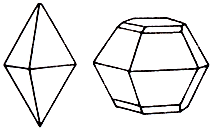
Sulfur is native - S. Shine is bold to diamond, the mineral is transparent to translucent. Colors: yellow, weathering turns gray or brown to black. The trait is light yellow, the fracture is conchoidal, uneven. Very fragile. Cleavage is imperfect. Sulfur is formed as a product of volcanic sublimations, it is also found in biogenic-sedimentary deposits.
Crystals (rhombic syngony) are pyramidal, barrel-shaped. Splices are frequent. Aggregates are solid coarse-grained, dense, sometimes earthy (there are grapesiform and kidney-like discharge), powdery raids. Used for the preparation of sulfuric acid, in the rubber industry and for the control of pests of agriculture. Places of distribution: Sicily Island (Italy), Spain. Poland, CIS, Japan, pcs. Louisiana (USA), Mexico.
Sulfur is an example of polymorphism. In the stable phase (up to 95 o C) rhombic syngony, in the interval up to 119 o C, becomes monoclinic. When the temperature rises, it melts. In nature, by virtue of this, it is found mainly in rhombic form. The sulfur forms bipyramidal crystals and granular aggregates. The color characteristic for this mineral is lemon yellow, which can vary up to almost black due to bitumen contamination.
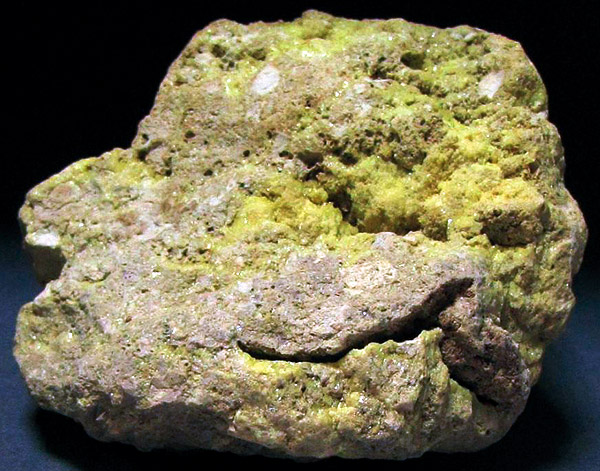
Sulfur (yellow). Guam Island, Pacific Ocean, USA. 10 cm. Photo: © А.А. Evseev.
 Sulfur (English Sulfur, French Sufre, German Schwefel) in a native state, as well as in the form of sulfur compounds is known from the most ancient times. With the smell of burning sulfur, the suffocating effect of sulfur dioxide gas and the hideous smell of hydrogen sulfide, man has probably met in prehistoric times. About half of the sulfur produced in the world is extracted from natural resources.
Sulfur (English Sulfur, French Sufre, German Schwefel) in a native state, as well as in the form of sulfur compounds is known from the most ancient times. With the smell of burning sulfur, the suffocating effect of sulfur dioxide gas and the hideous smell of hydrogen sulfide, man has probably met in prehistoric times. About half of the sulfur produced in the world is extracted from natural resources.
Diagnostic signs.
Fragile, poor conductor of heat; Sometimes enough to touch the hand to cause the crystal to crack. Charged with electricity when rubbing. It melts at a low temperature, burns in the air, releasing a poisonous gas of sulfuric anhydride.
Origin.
Sulfur is a mineral that is characteristic of sedimentary deposits such as evaporites and direct ("dry") volcanic sublimation, and also as an element of volcanic (thermal) sulfur sources (poisonous water and hot vapors of sulfur and acids). It is believed that it is formed by the decomposition of sulfates, primarily gypsum (with which it most often occurs together), under the influence of bacteria, especially "thiobacteria". The monoclinic phase is formed upon sublimation of sulfuric acid vapor in a volcanic medium (in solfatarars). In the photo - aggregates of sulfur crystals, commonly called "sulfur flowers".
Deposits and applications.
Large deposits of sulfur found in Texas and Louisiana in the roof of salt domes (evaporite deposits), overlain with clayey strata. Sulfur in these deposits is practically free of impurities, it is produced when drilling wells into which boiling water is injected. It melts the sulfur, which is then pumped to the surface (the Flash method).
Sulfur is also distributed in Italy along the outcrops of the gypsum sulfur-bearing stratum, which contour the Apennines, especially in Romagna, Marche, Calabria and Sicily. Sulfur is interlayered there with clayey rocks, so to extract it (now ceased), a rather complicated method is required. On the sulfur mines of Sicily, a method of extrusion was used. The sulfur extracted in the mine was melted and poured into large containers.

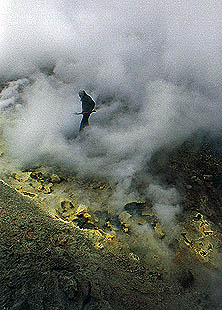
Other deposits are known in Japan and Indonesia. In Italy, very beautiful crystals of rhombic sulfur are known from Romagna, Marche (Perticara) and Sicily, where they are associated with celestine and aragonite. Monoclinic sulfur is installed in Campi Flegeri and on the island of Vulcano. Sulfur is used in the chemical industry and for the production of mineral fertilizers.
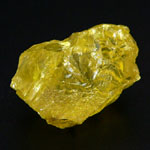
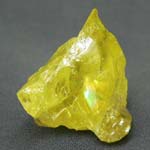
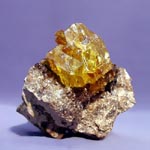

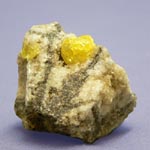
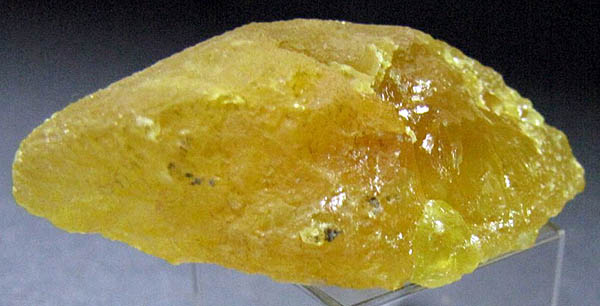
Sulfur (crystal). Sicily, Italy. 5x2.5 cm. Photo: © А.А. Evseev.
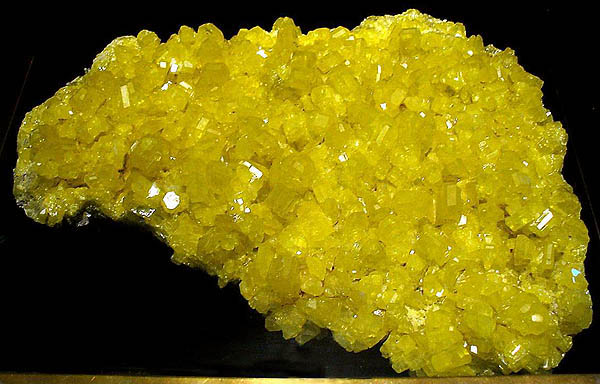
Brush of sulfur crystals (60x40 cm) from the island of Sicily (Italy). Photo: © В.И. Dvoryadkin.
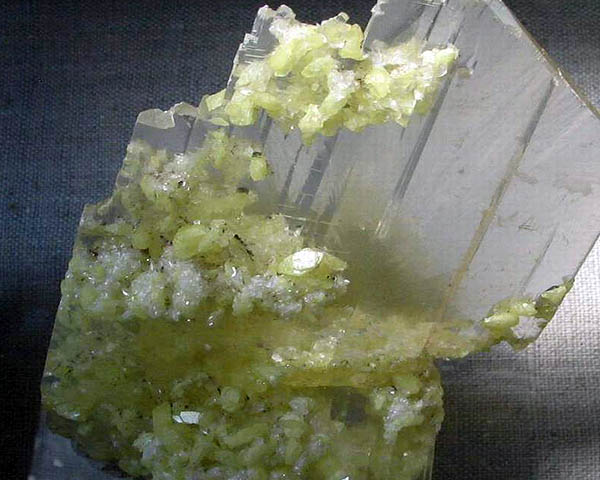
Sulfur. Drusa dipyramidal crystals on a crystal of colorless gypsum
And inside it. Sicily, Italy. Photo: © А.А. Evseev.
Sulfur is a "mineral of beauty" (a joke on the Soviet "zones", 1939-1969 of the 20th century, where the prisoners' salaries were including on sulfur). The sulfur content in the adult body is about 0.16% (110 g per 70 kg body weight). Sulfur is found in all tissues of the body, a lot of it in the muscles, skeleton, liver, nervous tissue, blood - an active metabolism. The yellow gray surface skin layers are rich, where sulfur is a part of keratin and melanin. These are sulphides. Sulfur enters the body with food products, as part of inorganic and organic compounds. Most of the sulfur enters the body as part of amino acids.
The main manifestations of excess sulfur: itching, rash, furunculosis, redness and swelling of the conjunctiva; The appearance of small point defects on the cornea; An aching in the eyebrows and eyeballs, a feeling of sand in the eyes; Photophobia, lacrimation, general weakness, headaches, dizziness, nausea, upper respiratory catarrh, bronchitis; Hearing impairment, digestive disorders, diarrhea, weight loss; Anemia, mental disorders, decreased intelligence. Sulfur - volcanoes and sulfuric springs, sulfur vapor (99.3%). Accumulate - products. One of the sources of excess sulfur is sulfur-containing compounds (sulfites), and the consumption of sulfites, which increases, is responsible for the increase in the incidence of bronchial asthma.
Sulfur is necessary: for pulmonary tuberculosis, articular rheumatism, inflammation, heartburn, arthritis, rhinitis, problems with hair (when the amount of creatine is lower than normal), joint pain, parasitic infection, irritable bowel syndrome, carpal sinus syndrome (occupational disease " Computer scientists "and typewriters), skin and nail diseases.
Signs of sulfur insufficiency: constipation, allergies, dullness and hair loss, brittle nails, high blood pressure, joint pain, tachycardia, high sugar levels and high triglycerides in the blood. Fatty degeneration of the liver, hemorrhage - in the kidneys, violations of protein and carbohydrate metabolism, overexcitation of the nervous system, irritability. Sulfur is a mineral that makes garlic "the king of plants."
Sulfur atoms are an integral part of the molecules of essential amino acids (cystine, cysteine, methionine), hormones (insulin, calcitonin), vitamins (biotin, thiamine), glutathione, taurine and other important compounds. In their composition, sulfur participates in oxidation-reduction reactions, tissue respiration processes, energy production, the transfer of genetic information, and performs many other important functions. Sulfur is a component of the collagen structural protein. Chondroitin sulfate is present in the skin, cartilage, nails, ligaments and valves of the myocardium. Serum-containing metabolites are hemoglobin, heparin, cytochromes, fibrinogen and sulfolipids.
Sulfur is excreted in the urine in the form of neutral sulfur and inorganic sulfates, a smaller part of sulfur is excreted through the skin and lungs, and is excreted mainly with urine in the form of SO42-. Endogenous sulfuric acid, formed in the body, takes part in neutralizing toxic compounds (phenol, indole, etc.), which are produced by the intestinal microflora, and also binds substances foreign to the body, including drugs and their metabolites. In this case, harmless compounds are formed-conjugates, which are then removed from the body. The exchange of sulfur is controlled by those factors that have a regulating effect on protein metabolism (hormones of the pituitary, thyroid, adrenal, gonadal glands).
ADR 2.1


Highly flammable gases
Risk of fire. Risk of explosion. Can be under pressure. Risk of suffocation. May cause burns and / or frostbite. Capacities can explode when heated (over-dangerous - almost do not burn)
Use shelter. Avoid low areas of the surface (pits, lowlands, trenches)
Red diamond, ADR number, black or white flame
ADR 2.2


Gas container Non-flammable, non-toxic gases.
Risk of suffocation. Can be under pressure. May cause frostbite (similar to a burn - pallor, blisters, black gas gangrene - creaking). Capacities can explode when heated (highly dangerous - explosion from a spark, flame, matches, practically do not burn)
Use shelter. Avoid low areas of the surface (pits, lowlands, trenches)
Green diamond, ADR number, black or white gas cylinder (such as "balloon", "thermos")
ADR 2.3

Toxic gases . Skull and crossbones
Danger of poisoning. Can be under pressure. May cause burns and / or frostbite. Capacities can explode when heated (highly dangerous - instantaneous gas spreading around the neighborhood)
Use the mask for emergency leaving the vehicle. Use shelter. Avoid low areas of the surface (pits, lowlands, trenches)
White diamond, ADR number, black skull and crossbones
ADR 3


Highly flammable liquids
Risk of fire. Risk of explosion. Capacities can explode when heated (highly dangerous - easily burned)
Use shelter. Avoid low areas of the surface (pits, lowlands, trenches)
Red diamond, ADR number, black or white flame
ADR 4.1

Highly flammable solids , self-reactive substances and solid desensitized explosives
Risk of fire. Flammable or combustible substances can ignite from sparks or flames. May contain self-reactive substances capable of exothermic decomposition in the case of heating, contact with other substances (such as: acids, heavy metal compounds or amines), friction or impact.
This can lead to the emission of harmful or flammable gases or vapor or spontaneous combustion. Containers can explode when heated (over-dangerous - practically do not burn).
Risk of explosion of desensitized explosives after loss of desensitizer
Seven vertical red stripes on a white background, equal in number, ADR number, black flame
ADR 8

Corrosive (corrosive) substances
Risk of burns from skin corrosion. They can react violently with each other (components), with water and other substances. The substance that spilled / crumbled can emit a corrosive vapor.
Dangerous to aquatic environment or sewer system
White upper half of diamond, black - lower, equal, ADR number, test tubes, hands
| The name of a cargo that is particularly dangerous for transportation | room
UN |
Class
ADR |
| Sulfur anhydride, stabilized Sulfur trioxide, stabilized | 1829 | 8 |
| Anhydride seric Sulfur Dioxide | 1079 | 2 |
| Carbon disulfide carbon | 1131 | 3 |
| Sulfur Hexafluoride Gas | 1080 | 2 |
| SULFURIC ACID | 1832 | 8 |
| SULFURIC ACID SULFURIC ACID | 1831 | 8 |
| SULFURIC ACID, which contains no more than 51% acid, or LIQUID BATTERY ACID | 2796 | 8 |
| SULFURIC ACID, REGENERATED FROM ACID GOODONE | 1906 | 8 |
| SULFURIC ACID, which contains more than 51% acid | 1830 | 8 |
| SULFURIC ACID | 1833 | 8 |
| SULFUR | 1350 | 4.1 |
| SULFURICALLY SOLUBLE | 2448 | 4.1 |
| Sulfur chloride, sulfuric chlorides | 1828 | 8 |
| Sulfur hexafluoride Sulfur hexafluoride | 1080 | 2 |
| Sulfur dichloride | 1828 | 8 |
| SULFUR DIOXIDE | 1079 | 2 |
| SULFUR TETRAFLUORIDE | 2418 | 2 |
| SULFUR STOYLIDE STABILIZED SULFUR | 1829 | 8 |
| SULFUR CHLORIDE | 1828 | 8 |
| SULFUR HYDROGEN | 1053 | 2 |
| Sulfur Carbon | 1131 | 3 |
| MATCHES SAFE in boxes, books, cartons | 1944 | 4.1 |
| MATCHES PARAFFIN "VESTA" | 1945 | 4.1 |
| Matches paraffin MATCH PARAFFIN "VESTA" | 1945 | 4.1 |
| MATCH MATCHES | 2254 | 4.1 |
Poisonous and radioactive dangerous stones and minerals
** - poisonous stones and minerals (mandatory check in the chemical laboratory + explicit indication of toxicity)
** - radioactive stones and minerals (mandatory check on the standard dosimeter + ban on open sales in case of radioactivity exceeding 24 milli / g / h + additional measures of population protection)
Catalog of minerals and semi-precious stones of the world by groups
** - poisonous stones and minerals
** - radioactive stones and minerals


Comments
When commenting on, remember that the content and tone of your message can hurt the feelings of real people, show respect and tolerance to your interlocutors even if you do not share their opinion, your behavior in the conditions of freedom of expression and anonymity provided by the Internet, changes Not only virtual, but also the real world. All comments are hidden from the index, spam is controlled.